2014 Peugeot 308 ECO mode
[x] Cancel search: ECO modePage 112 of 400
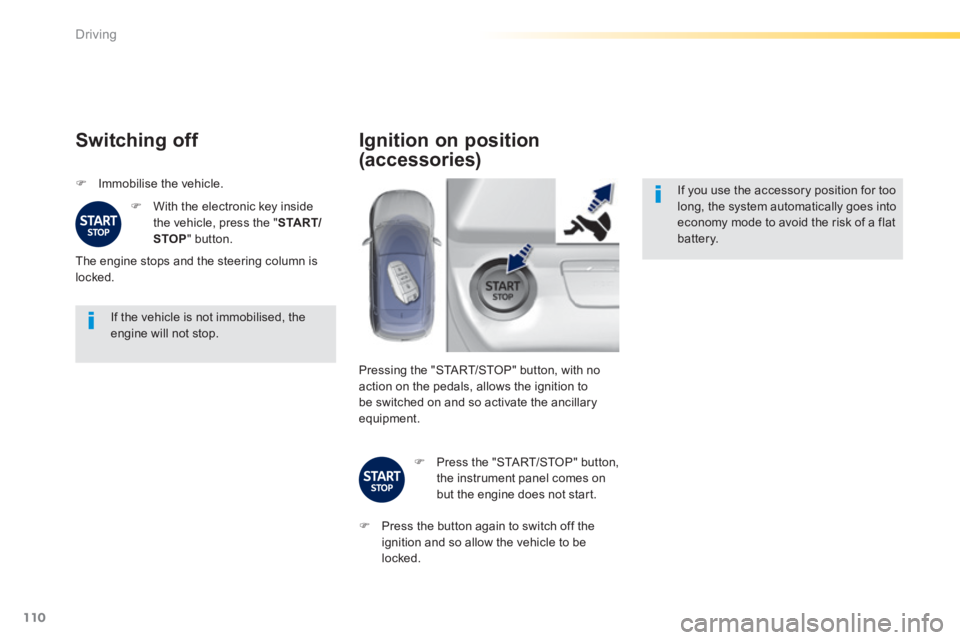
110
Driving
308_EN_CHAP04_CONDUITE_ED02-2013
If the vehicle is not immobilised, the engine will not stop.
Switching off
Immobilise the vehicle.
With the electronic key inside the vehicle, press the " S TA R T/STOP " button.
The engine stops and the steering column is locked.
Ignition on position
(accessories)
If you use the accessory position for too long, the system automatically goes into economy mode to avoid the risk of a flat battery.
Pressing the "START/STOP" button, with no action on the pedals, allows the ignition to be switched on and so activate the ancillary equipment.
Press the "START/STOP" button, the instrument panel comes on but the engine does not start.
Press the button again to switch off the ignition and so allow the vehicle to be locked.
Page 129 of 400
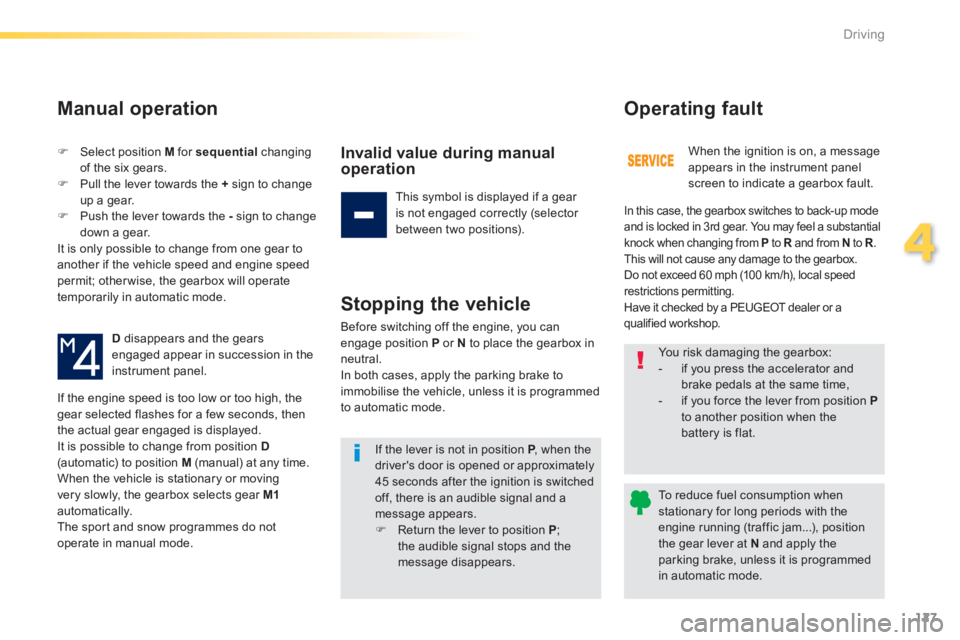
127
4
Driving
308_EN_CHAP04_CONDUITE_ED02-2013
Select position M for sequential changing of the six gears. Pull the lever towards the + sign to change up a gear. Push the lever towards the - sign to change down a gear. It is only possible to change from one gear to another if the vehicle speed and engine speed permit; otherwise, the gearbox will operate temporarily in automatic mode.
D disappears and the gears engaged appear in succession in the instrument panel.
If the engine speed is too low or too high, the gear selected flashes for a few seconds, then
the actual gear engaged is displayed. It is possible to change from position D(automatic) to position M (manual) at any time. When the vehicle is stationary or moving very slowly, the gearbox selects gear M1automatically. The sport and snow programmes do not operate in manual mode.
Manual operation
Invalid value during manual operation
This symbol is displayed if a gear is not engaged correctly (selector between two positions).
Stopping the vehicle
Before switching off the engine, you can engage position P or N to place the gearbox in neutral. In both cases, apply the parking brake to immobilise the vehicle, unless it is programmed
to automatic mode.
If the lever is not in position P , when the P , when the Pdriver's door is opened or approximately 45 seconds after the ignition is switched off, there is an audible signal and a message appears. Return the lever to position P ; the audible signal stops and the message disappears.
When the ignition is on, a message appears in the instrument panel screen to indicate a gearbox fault.
Operating fault
In this case, the gearbox switches to back-up mode and is locked in 3rd gear. You may feel a substantial knock when changing from P to R and from R and from RN to R . R . RThis will not cause any damage to the gearbox. Do not exceed 60 mph (100 km/h), local speed restrictions permitting. Have it checked by a PEUGEOT dealer or a qualified workshop.
You risk damaging the gearbox: - if you press the accelerator and brake pedals at the same time, - if you force the lever from position Pto another position when the battery is flat.
To reduce fuel consumption when stationary for long periods with the engine running (traffic jam...), position
the gear lever at N and apply the parking brake, unless it is programmed in automatic mode.
Page 131 of 400

129
4
Driving
308_EN_CHAP04_CONDUITE_ED02-2013
Stop & Start
Operation
Going into engine STOP mode
The "ECO" warning lamp comes on in the instrument panel and the engine goes into standby automatically:
- With a manual gearbox , at speeds below 12 mph (20 km/h) or vehicle stationary (depending on the engine), when you place the gear lever in neutral, and you release the clutch pedal.
Never refuel with the engine in STOP mode; you must switch off the ignition with the button.
For your comfort, during parking maoeuvres, STOP mode is not available for a few seconds after coming out of reverse gear. STOP mode does not affect the functionality of the vehicle, such as for example, braking, power steering...
Special cases: STOP mode not available
STOP mode is not invoked principally when: - the vehicle is on a steep slope (up or d ow n), - the driver's door is open, - the driver's seat belt is not fastened, - the vehicle has not exceeded 6 mph (10 km/h) since the last engine start by the driver, - the electric parking brake is applied or being applied, - the engine is needed to maintain a comfortable temperature in the passenger compartment,
- demisting is active, - some special conditions (battery charge, engine temperature, braking assistance, ambient temperature...) where the engine is needed to assure control of a system.
If your vehicle is fitted with Stop & Start, a time counter calculates the time spent in STOP mode during a journey.
In this case, the "ECO" warning lamp flashes for a few seconds then goes of f. This operation is perfectly normal.
The Stop & Start system puts the engine temporarily into standby - STOP mode - during stops in the traffic (red lights, traffic jams, or other...). The engine restarts automatically - START mode - as soon as you want to move off. The restart takes place instantly, quickly and silently. Per fect for urban use, the Stop & Start system reduces fuel consumption and exhaust emissions as well as the noise level when stationary.
Stop & Start time counter
(minutes / seconds or hours / minutes)
- With an automatic gearbox , vehicle stationary, when you press the brake pedal or place the gear selector lever in position N .
It resets to zero every time the ignition is switched on.
Page 132 of 400
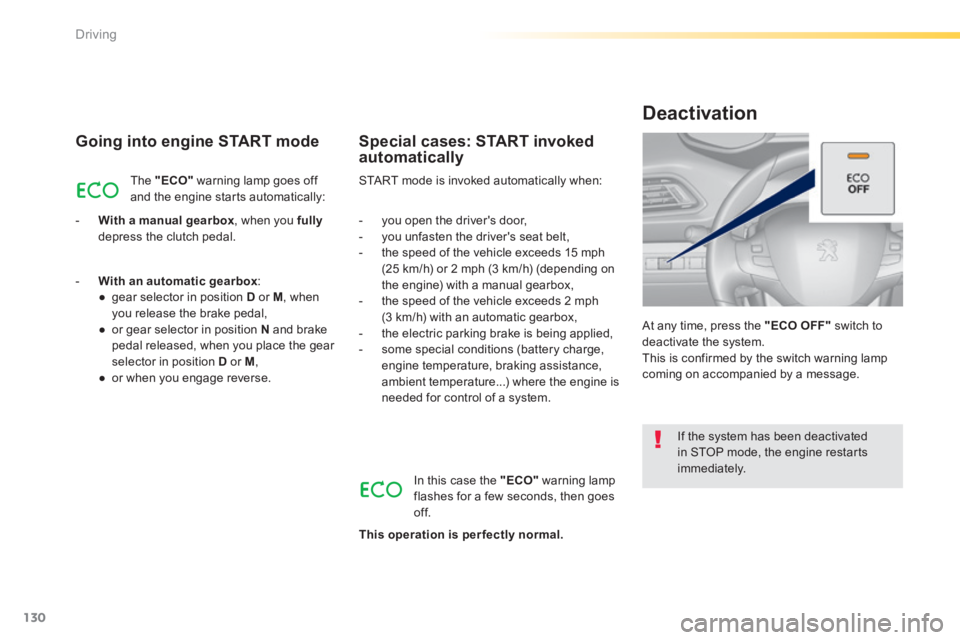
130
Driving
308_EN_CHAP04_CONDUITE_ED02-2013
Going into engine START mode
The "ECO" warning lamp goes off and the engine starts automatically:
- With a manual gearbox , when you fullydepress the clutch pedal.
START mode is invoked automatically when:
Special cases: START invoked automatically
- you open the driver's door, - you unfasten the driver's seat belt, - the speed of the vehicle exceeds 15 mph (25 km/h) or 2 mph (3 km/h) (depending on the engine) with a manual gearbox, - the speed of the vehicle exceeds 2 mph (3 km/h) with an automatic gearbox, - the electric parking brake is being applied, - some special conditions (battery charge, engine temperature, braking assistance, ambient temperature...) where the engine is needed for control of a system.
If the system has been deactivated in STOP mode, the engine restarts immediately.
At any time, press the "ECO OFF" switch to deactivate the system. This is confirmed by the switch warning lamp coming on accompanied by a message.
Deactivation
In this case the "ECO" warning lamp flashes for a few seconds, then goes of f.
This operation is perfectly normal.
- With an automatic gearbox : ● gear selector in position D or M , when you release the brake pedal, ● or gear selector in position N and brake pedal released, when you place the gear selector in position D or M , ● or when you engage reverse.
Page 133 of 400
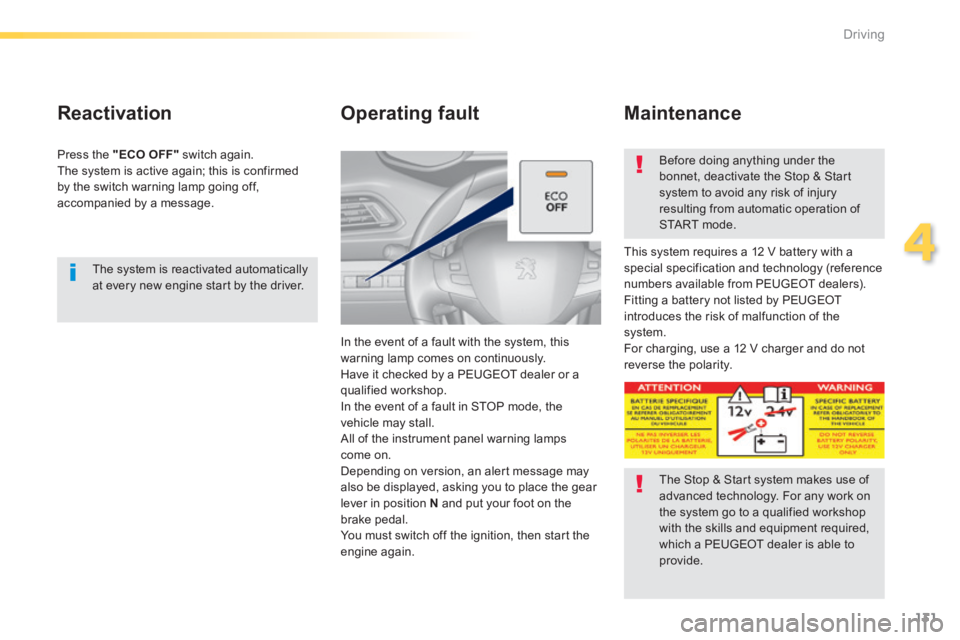
131
4
Driving
308_EN_CHAP04_CONDUITE_ED02-2013
The system is reactivated automatically at every new engine start by the driver.
Reactivation
Press the "ECO OFF" switch again. The system is active again; this is confirmed by the switch warning lamp going off, accompanied by a message.
Operating fault
In the event of a fault with the system, this warning lamp comes on continuously. Have it checked by a PEUGEOT dealer or a qualified workshop. In the event of a fault in STOP mode, the vehicle may stall.
All of the instrument panel warning lamps come on. Depending on version, an alert message may also be displayed, asking you to place the gear lever in position N and put your foot on the brake pedal. You must switch off the ignition, then start the engine again.
Before doing anything under the bonnet, deactivate the Stop & Start system to avoid any risk of injury resulting from automatic operation of START mode.
This system requires a 12 V battery with a special specification and technology (reference numbers available from PEUGEOT dealers). Fitting a battery not listed by PEUGEOT introduces the risk of malfunction of the system. For charging, use a 12 V charger and do not reverse the polarity.
Maintenance
The Stop & Start system makes use of advanced technology. For any work on the system go to a qualified workshop with the skills and equipment required,
which a PEUGEOT dealer is able to provide.
Page 138 of 400

136
Driving
308_EN_CHAP04_CONDUITE_ED02-2013
Steering mounted controls
The information is grouped together in the instrument panel. 6. Cruise control pause / resume indication. 7. Cruise control mode selection indication. 8. Speed value setting.
Cruise control
System which automatically maintains the speed of the vehicle at the value programmed by the driver, without any action on the accelerator pedal.
The cruise control system cannot, in any circumstances, replace the need to observe speed limits, nor can it replace the need for vigilance and responsibility on the part of the driver. You are advised to keep your feet near the pedals
at all times.
The cruise control is switched on manually: it requires a minimum vehicle speed of 25 mph (40 km/h).
The controls of this system are grouped together at the steering wheel. 1. Cruise control mode selection wheel. 2. Decrease value or speed setting on the fly button. 3. Increase value or speed setting on the fly
button. 4. Cruise control pause / resume button. 5. Memorised speeds display button.
Displays in the instrument panel
Switching off the ignition cancels any programmed speed value.
The cruise control is paused manually or by pressing the brake or clutch pedal or on triggering of the ESC system for safety reasons. It is possible to exceed the programmed speed temporarily by pressing the accelerator pedal. To return to the programmed speed, simply release the accelerator pedal until the programmed cruise speed is reached again.
As well as the engagement of at least third or fourth gear (depending on engine) on a manual gearbox.
For more information on the list of
memorised speeds, refer to the "Memorising speeds" section.
As well as the engagement of at least second
gear (depending on engine) on an automatic gearbox.
Page 139 of 400
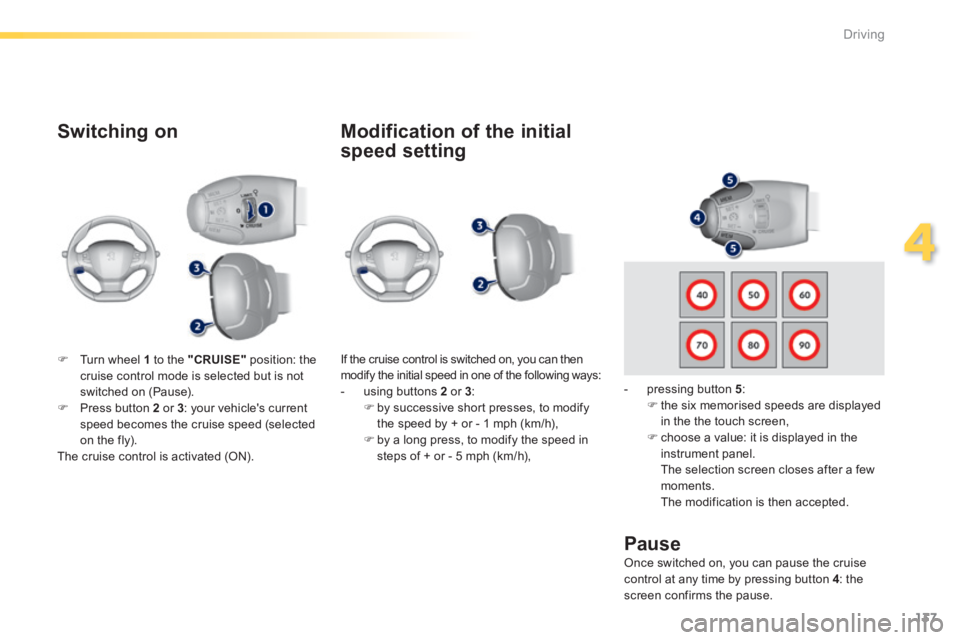
137
4
Driving
308_EN_CHAP04_CONDUITE_ED02-2013
Switching on
If the cruise control is switched on, you can then modify the initial speed in one of the following ways: - using buttons 2 or 3 : by successive short presses, to modify the speed by + or - 1 mph (km/h), by a long press, to modify the speed in steps of + or - 5 mph (km/h),
Pause
Turn wheel 1 to the "CRUISE" position: the cruise control mode is selected but is not switched on (Pause). Press button 2 or 3 : your vehicle's current speed becomes the cruise speed (selected on the fly). The cruise control is activated (ON).
Modification of the initial
speed setting
- pressing button 5 : the six memorised speeds are displayed in the the touch screen,
choose a value: it is displayed in the instrument panel. The selection screen closes after a few moments. The modification is then accepted.
Once switched on, you can pause the cruise control at any time by pressing button 4 : the screen confirms the pause.
Page 141 of 400
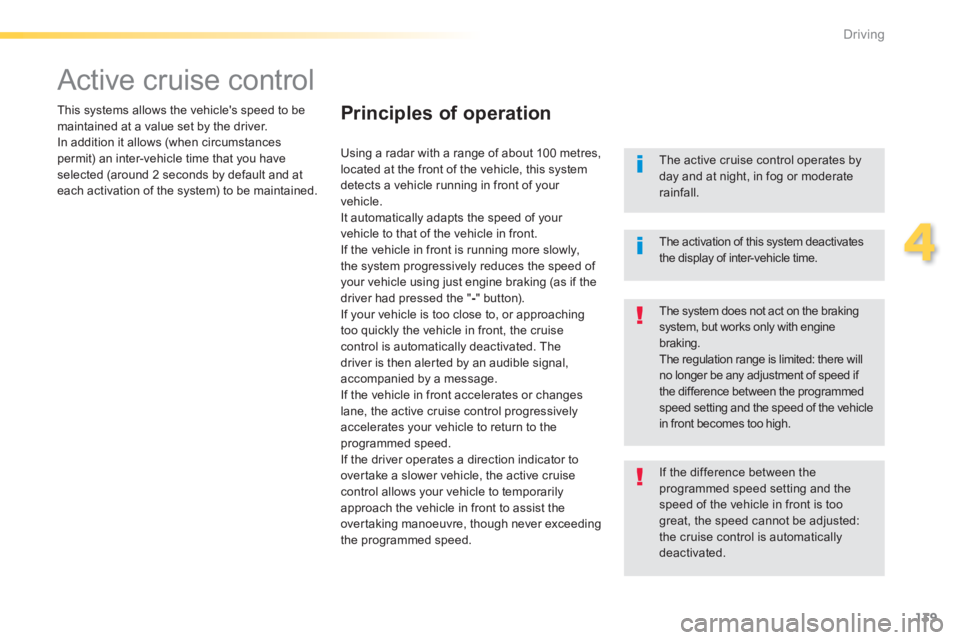
139
4
Driving
308_EN_CHAP04_CONDUITE_ED02-2013
Active cruise control
This systems allows the vehicle's speed to be maintained at a value set by the driver. In addition it allows (when circumstances permit) an inter-vehicle time that you have selected (around 2 seconds by default and at each activation of the system) to be maintained.
Principles of operation
Using a radar with a range of about 100 metres, located at the front of the vehicle, this system detects a vehicle running in front of your vehicle. It automatically adapts the speed of your
vehicle to that of the vehicle in front. If the vehicle in front is running more slowly, the system progressively reduces the speed of your vehicle using just engine braking (as if the driver had pressed the " - " button). If your vehicle is too close to, or approaching too quickly the vehicle in front, the cruise control is automatically deactivated. The driver is then alerted by an audible signal, accompanied by a message. If the vehicle in front accelerates or changes lane, the active cruise control progressively accelerates your vehicle to return to the programmed speed. If the driver operates a direction indicator to overtake a slower vehicle, the active cruise control allows your vehicle to temporarily approach the vehicle in front to assist the overtaking manoeuvre, though never exceeding
the programmed speed.
The active cruise control operates by day and at night, in fog or moderate rainfall.
The system does not act on the braking system, but works only with engine braking. The regulation range is limited: there will no longer be any adjustment of speed if the difference between the programmed speed setting and the speed of the vehicle in front becomes too high.
The activation of this system deactivates the display of inter-vehicle time.
If the difference between the programmed speed setting and the speed of the vehicle in front is too great, the speed cannot be adjusted:
the cruise control is automatically deactivated.